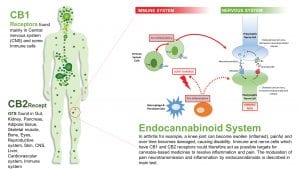
GreenLight Medicines has positioned itself at the forefront of medical cannabis research, here they take a look at the endocannabinoid system.
GreenLight was established in 2014 in Ireland with two subdivisions – Greenlight Supplements Ltd manufactures and markets a range of FSAI compliant products including cannabidiol supplements in Europe; and GreenLight Pharmaceuticals Ltd (trading as GreenLight Medicines), a biopharmaceutical company focused on the research and development of safe and effective plant based medicines. Here, the company overviews the science behind the endocannabinoid system, and what their research interests are.
Although GreenLight specialises in phytocannabinoid supplement production and clinical development, it performs research on the potential health benefits of a wide range of plant based compounds. The company is based in Dublin, but has recently created a UK based subsidiary and has plans to expand into Europe.
The endocannabinoid system as a pharmacological target
The endocannabinoid system (ECS) is a multifaceted biological entity consisting of three primary components. Receptors, endogenous cannabinoid (endocannabinoids) and enzymes that synthesise and break down endocannabinoid molecules (Fig. 1).

The primary ECS receptors were discovered in 1990 by Dr Herkenham at the US National Institute of Mental Health. These receptors are cell surface molecules that bind to endogenous cannabinoid molecules, which in turn can trigger changes in cell behaviour. The location of these receptors is important as they are involved in several pharmacologically beneficial areas. The CB1 receptor is predominantly found in the brain and the central and peripheral nervous system. CB2 receptors are located primarily in immune organs such as the spleen, tonsils and the thymus gland, and also located in immune cells such as B-cells, T-cells and macrophages (Fig. 1).
In 1992, Dr Raphael Mechoulam and colleagues based in Israel identified the first endogenous cannabinoid called anandamide, 60 years after the discovery of the key plant phytocannabinoid structures by Dr Adams in the US (Δ9-tetrahydrocannabinol (THC) and cannabidiol (CBD)). Endocannabinoids are synthesised from arachidonic acid, obtained from diets containing omega-6-fatty acids. The two endocannabinoids of primary interest are anandamide and 2-arachidonylglycerol. These endocannabinoids bind to the cannabinoid receptors and are thought to regulate sleep, metabolism, mood, motor control, immune function and pain.
Medical cannabis contains many cannabinoid molecules that mimic these endocannabinoids, making the plant a potentially useful medicine. THC is the most studied of all the phytocannabinoids, as it binds to both the CB1 and CB2 cannabinoid receptors located throughout the brain and body. CBD binds weakly at both CB1 and CB2 receptors, with most of its therapeutic action thought to modulate the ECS through pathways including a serotonin receptor.
ECS in Neurotransmission
During signalling between nerve endings in the body (neurotransmission) the presynaptic neuron releases neurotransmitter molecules into the synaptic cleft (space between neighbouring nerve endings). A typical molecular signalling event could for example be the ‘communication’ of pain from injured parts of the body to the brain. These molecules bind with neuroreceptors on the postsynaptic neuron (Fig. 1). The ECS acts to control or modulate this basic system.
Once the postsynaptic neuron has been activated, endocannabinoids such as anandamide and 2AG are synthesised and released into the synaptic cleft and travel back to the presynapse where they bind to CB receptors, triggering a reduction in neurotransmitter activity – in other words, it is a type of feedback loop.
The endocannabinoid system therefore acts as a ‘fine tuner’ or controller of the release of other neurotransmitters. As soon as endocannabinoids have interacted with receptors, they in turn are broken down by enzymes including fatty acid amide hydrolase (FAAH). Thus, endocannabinoids can be synthesised and then broken down on demand. As the ECS therefore has potential to moderate errant nervous and immune system signalling, basic science studies of plant-based phytocannabinoids could offer potentially new ways to treat a range of conditions.
The ECS is involved in pain reception, by modulating the effects of the other neurotransmitters involved in pain response such as the noradrenaline and gamma-aminobutyric acid signalling systems. The most commonly reported anecdotal effects of THC are pain relief and appetite stimulation. Various scientific studies have produced evidence that it could be useful in reducing inflammation (swelling), anxiety and depression and nausea due to other treatments.
However, as a 2018 Cochrane review concluded, there is a lack of good clinical evidence that cannabis-derived medicines work for chronic neuropathic pain (see our previous Health Europa article here). This does not mean that cannabis-based medicines don’t have any potential against pain, it is more that the quality of evidence is so low from existing studies that only limited conclusions can be made. GreenLight Medicines is conducting research on whether specific cannabinoids reduce inflammation and pain in arthritis. The strongest evidence to date of efficacy, albeit ‘moderate’ in nature, emerges from multiple sclerosis, cancer nausea and epilepsy randomised controlled trials.
Expanding medical cannabis research
GreenLight Pharmaceuticals Ltd. currently has nine therapeutic research and development projects based across 3 core disease areas:
- Cancers including prostate, ovarian and breast;
- Neurological conditions including Alzheimer’s, epilepsy, addiction and pain; and
- Inflammatory or immune related conditions including arthritis and arthritis related depression, eye disease and diabetes (rationale showcased below). They also have a plant breeding project to optimise proprietary strains and a dedicated lab to purify and screen compound mixtures, prior to pre-clinical testing in each research programme.
Cytokines are molecules produced by cells during tissue injury, swelling and repair, which can signal to other cells to become involved. Cytokines can moderate levels of inflammation and are generally found at higher levels in conditions such as arthritis, contributing to joint damage and ultimately disability.
Current studies suggest that specific cannabinoids can suppress inflamed states of immune system cells, by increasing immunosuppressive cytokines and reducing T-cell activating cytokines (Fig. 1).
In doing so, cannabinoids may also reduce sensitisation of nerve endings to pain. Clinical trials conducted to date on cannabinoid treatments (usually with CBD: THC in combination) are inconclusive on whether they are effective in arthritis. There are a number of plausible reasons for this, including the specific treatment composition, doses used, modes of delivery and poor trial design.
GreenLight plans on expanding its program of research into the anti-cancer potential of phytocannabinoids and other plant-based compounds. The company also plans phase II clinical trials of investigational medical products in both arthritic pain and epilepsy.
References
- Chanda D, Neumann D, Glatz JFC. The endocannabinoid system: Overview of an emerging multi-faceted therapeutic target. Prostaglandins Leukot Essent Fatty Acids. 2019 Jan; 140:51-56.
- Castillo PE, Younts TJ, Chávez AE, Hashimotodani Y. Endocannabinoid signaling and synaptic function. Neuron. 2012 Oct 4;76(1):70-81.
- Howlett AC, Bidaut-Russell M, Devane WA, Melvin LS, Johnson MR, Herkenham M. The cannabinoid receptor: biochemical, anatomical and behavioural characterization. Trends Neurosci. 1990 Oct;13(10):420-3.
- Maccarrone M, Bab I, Bíró T, Cabral GA, Dey SK, Di Marzo V, Konje JC, Kunos G, Mechoulam R, Pacher P, Sharkey KA, Zimmer A. Endocannabinoid signaling at the periphery: 50 years after THC. Trends Pharmacol Sci. 2015 May;36(5):277-96.
- Mücke M, Phillips T, Radbruch L, Petzke F, Häuser W. Cannabis-based medicines for chronic neuropathic pain in adults. Cochrane Database Syst Rev. 2018 Mar 7;3:CD012182.
David Gibson PhD
Chief Scientific Officer
Green Light Medicines
david.gibson@greenlightmedicines.com
Tweet @greenlightmeds
www.greenlightmedicines.com
This article will appear in Health Europa Quarterly Issue 11, which is available to read now.



















Do you have any experience or results for multiple sclerosis? Does de cannabidiol system help to restitute mielin?